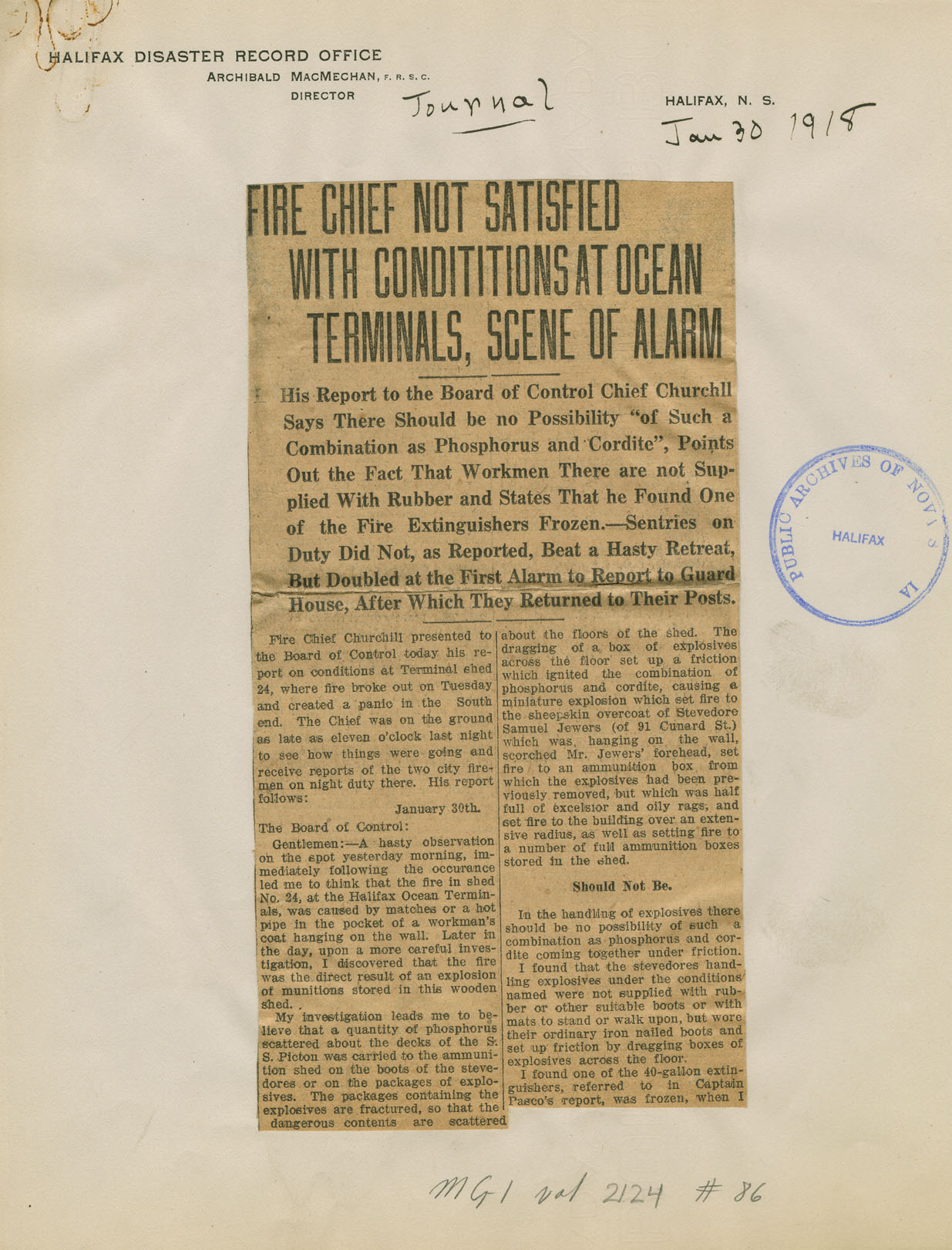Nova Scotia Archives
Archibald MacMechan
Halifax Disaster Record Office Materials
"Journal", clipping
30 January 1918. — 2 pages : 30 x 40 cm.
note: transcription publicly contributed - please contact us with comments, errors or omisions
Halifax Disaster Record Office
Archibald MacMechan, F. R. S. C.
Director
Halifax, N. S.
Journal
Jan 30 1918
FIRE CHIEF NOT SATISFIED WITH CONDITIONS AT OCEAN TERMINALS, SCENE OF ALARM
His Report to the Board of Control Chief Churchll Says There Should be no Possibility "of Such a Combination as Phosphorus and Cordite", Points Out the Fact That Workmen There are not Supplied With Rubber and States That he Found One of the Fire Extinguishers Frozen. - Sentries on Duty Did Not, as Reported, Beat a Hasty Retreat, But Doubled at the First Alarm to Report to Guard House, After Which They Returned to Their Posts.
Fire Chief Churchill presented to the Board of Control today his report on conditions at Terminal shed 24, where fire broke out on Tuesday and created a panic in the South end. The Chief was on the ground as late as eleven o'clock last night to see how things were going and receive reports of the two city fire-men on night duty there. His report follows:
January 30th.
The Board of Control:
Gentlemen: - A hasty observation on the spot yesterday morning, immediately following the occurance led me to think that the fire in shed No. 24, at the Halifax Ocean Terminals, was caused by matches or a hot pipe in the pocket of a workman's coat hanging on the wall. Later in the day, upon a more careful investigation, I discovered that the fire was the direct result of an explosion of munitions store in this wooden shed.
My investigation leads me to be believe that a quantity of phosphorus scattered about the decks of the S. S. Picton was carried to the ammunition shed on the boots of the stevedores or on the packages of explosives. The packages containing the explosives are fractured, so that the dangerous content are scattered about the floors of the shed. The dragging of a box of explosives across the floor set up a friction which ignited the combination of phosphorus and cordite, causing a miniature explosion which set fire to the sheepskin overcoat of Stevedore Samuel Jewers (of 91 Cunard St.) which was hanging on the wall, scorched Mr. Jewers' forehead, set fire to an ammunition box from which the explosives had been previously removed, but which was half full of excelsior and oily rags, and set fire to the building over an extension radius, as well as setting fire to a number of full ammunition boxes store in the shed.
Should Not Be.
In the handling of explosives there should be no possibility of such a combination as phosphorus and cordite coming together under friction. I found that the stevedores handling explosives under the conditions named were not supplied with rubber or other suitable boots or with mats to stand or walk upon, but wore their ordinary iron nailed boots and set up friction by dragging boxes of explosives across the floor. I found one of the 40-gallon extinguishers, referred to in Captain Pasco's report, was frozen, when I
Reference: Archibald MacMechan Nova Scotia Archives MG 1 volume 2124 number 86

